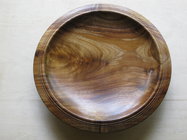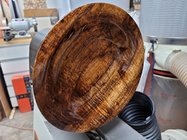For me, to be totally 'food safe' that means I have to be able to eat it straight out of the can. That limits me to walnut oil. I did try mineral oil and didn't like it since it offered no real protection. I have heard of using grape seed oil and hemp oil. Not sure how coconut oil would work. The problem with a lot of 'natural' oils is that they don't polymerize. You can do that with vegetable oils if you heat them properly, like what you do for your cast iron pots and pans. I did chat with one woman who was sensitive to some of the commercial drying agents in the polymer type finishes and she said they still bothered her after they were supposed to be 'inert materials'. When I first started turning, many said don't use olive oil because it would go rancid. As near as I can tell, if you leave it on the surface of the wood and it starts to build up, then it can go rancid. If you keep the build up off, and the bowl clean, this is not a problem. Never had a chance to play with Tasmanian Blackwood..... Yet!
robo hippy


